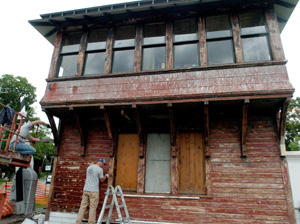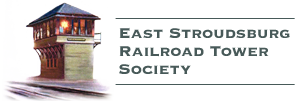About the Tower
By Kendrick Bisset, President
East Stroudsburg Railroad Tower Society
and Amy Leiser, Executive Director
Monroe County Historical Association
The history of Monroe County’s rail lines began over 150 years ago. The Delaware, Lackawanna and Western Railroad established tracks on the east side of the Brodhead Creek, and the first train to New York from Scranton passed through East Stroudsburg on May 13, 1856.
Near the corner of Lackawanna and Analomink Streets in East Stroudsburg stands a strange, small building. Only about 15 by 21 feet, it stands two stories tall, and is next to the railroad track. Some people know that it is (or perhaps more accurately, was) a railroad signal tower. With many windows in the upper floor, a man could be seen working inside. But it was private, not open to the public, and perhaps there was a bit of a mystery about what it was for and why it was there. Anecdotal evidence suggests that the tower was not as private as the railroad perhaps would have liked, for there are stories (and a few pictures) of illicit visitors. Even those visitors were probably a bit mystified as to how the tower worked, and why it was there.
This is the (East) Stroudsburg Tower (the Delaware, Lackawanna and Western Railroad often omitted the “East”); it controlled the switches and signals on the main tracks between about Broad Street and opposite Federal Street. When the tower was built in 1908, there were two main tracks from Federal St. to Hoboken, and four tracks from Broad St. to Henryville (about 9 miles north of the tower), and then at least two tracks beyond. There were other tracks and switches in the area, but these were not controlled from the tower.
Large levers inside the tower operated the switches and signals through mechanical connections. Through links and cranks, the levers pushed and pulled rods alongside the track to move switches, signals and locking devices. The levers are equipped with mechanical locking so that they can only be moved in the correct sequence. First, the switches must be positioned, then the switches must be locked, and only then can the signal be cleared. Once the signal is cleared, the switches and locks cannot be moved. The interlocking between the levers gives the name “interlocking machine” to the assembly of levers. The power to move the levers, switches, locks, and signals came from the tower operator’s arms – hence, the nickname for this type of interlocking: an “armstrong” machine.
The Stroudsburg tower has 38 levers, and when built, all 38 levers were used. This is unusual; spare levers, or at least spare spaces, were almost always provided. Over the years, some switches and signals were removed, and so a few levers became spare. A major change came in about 1937, when the mechanical signals (“semaphores”) were replaced by color light signals (red, yellow and green lights). The relays and circuits for this change required the installation of the concrete relay house next to the tower. Since only one lever was needed to control a signal (instead of as many as three levers for the three semaphore arms on a signal), many more levers became spares.
Two of the levers in the tower operated mechanical crossing gates across Analomink Street, just outside the tower. There were four gates, two on each side of the tracks. When lowered, the gates provided a barricade to road traffic completely across the street. Today, the mechanical gates have been replaced by automatic electrically-operated gates with flashing lights.
The tower was manned 24 hours a day, seven days a week. Only one man (women almost never worked as tower operators) was always on duty. The tower is equipped with a toilet and sink, though in 1908 there may have been just an outhouse. Heat was provided by a coal stove in the downstairs room, but there was a central steam boiler for the Stroudsburg area which probably heated the tower (as well as several other buildings) originally.
In 1917, there were over 4,000 mechanical towers across the United States. Today, there are none in service, and only a handful have been preserved. Where did all of these towers go? Some were replaced with power interlocking machines, where the levers were still mechanically interlocked, but switches and signals were operated by electricity or compressed air. Some were abandoned when tracks were abandoned. The Stroudsburg tower contains an example of a signal system which replaced many other towers.
There were several other towers in the area. West Henryville controlled the west end of tracks 3 and 4; Analomink controlled the entrance to the small yard there; Gravel Place (near present Mill Creek Road) controlled connections to the roundhouse for helper locomotives; and Slateford Junction controlled the junction between the “old main” and the new (in 1911) cutoff across New Jersey. These towers were all manned full time. In 1942, the tower at West Henryville was replaced by an electric interlocking, remotely controlled from the Gravel Place tower. A similar remote controlled electric interlocking was installed at Analomink; the tower there had been closed in 1932. The new system, known as Centralized Traffic Control (CTC), allowed one operator to control several interlockings, with controls and indications transmitted over a single pair of wires. Small levers and indication lights allowed operation without much physical effort; the switches were equipped with electric motors, and the locking was performed electrically instead of mechanically. The small CTC machine was moved from Gravel Place to Stroudsburg in 1950, and the interlocking at Gravel Place was closed. Then, in 1955, major flooding as a result of hurricane Diane destroyed the double-track bridge over the Brodhead Creek east (geographically south) of the tower. Bell’s Bridge, as it was known, was replaced with a single track bridge. To control trains using the single track, two interlockings were added to the CTC machine, which were named “Bell’s bridge” and “West End Slateford”, though the latter was originally a long distance west of the former Slateford tower. [This paragraph has been revised – December 2021.]
The Lackawanna carried a significant amount of traffic, both freight and passenger. As late as 1958, there were seven passenger trains a day in each direction past the Stroudsburg tower, and many more freight trains. The main line was double track all the way from Hoboken to Buffalo, and these tracks received heavy use. Even with this level of traffic, the Lackawanna, along with other railroads in the northeast, was in financial trouble even before hurricanes Connie and Diane hit the Poconos in August, 1955. The rainfall from the two hurricanes destroyed several areas of the Lackawanna’s track, and brought all rail traffic in the Poconos to a halt for several weeks. Among much other damage, Bell’s Bridge, about two and a half miles east of Stroudsburg, was destroyed. This double track bridge was replaced by a single track bridge in September 1955.
The weakened Lackawanna finally merged with the Erie Railroad in October, 1960 to form the Erie Lackawanna. Passenger service through Stroudsburg ended in January, 1970. The Erie Lackawanna, in turn, merged with other railroads to form Conrail on April 1, 1976. During this time, rail traffic declined and track and signal systems were removed. As far as we know, the tower was finally removed from service in 1986.
That the tower has survived since its closure is something of a miracle. Conrail seemed to have a policy of scrapping abandoned facilities, but for some reason the tower did not suffer this fate. The largest piece of equipment in the tower, the mechanical interlocking machine, is largely intact. Some parts are missing, and work is needed to re-assemble some of the levers, but the mechanical locking can be demonstrated. The CTC machine was missing many of the levers and lights, but we have been able to make a good start on replacing and re-creating much of this equipment, at least cosmetically.
The East Stroudsburg Railroad Tower Society has been working for about ten years to restore the tower. Much of the effort has been devoted to the building: the last, or at least one of two, wood Lackawanna towers remaining. The roof is tight, windows have been replaced, there is new paint inside and out, and there is new electrical wiring. The all-volunteer non-profit Society has begun to work on the signal equipment inside.
» Visit the Monroe County Historical Association
The Tower in the News
» A piece of East Stroudsburg’s railroad history
As seen in the Pocono Record – 8/12/15
» East Stroudsburg Railroad Tower restoration
As seen in the Pocono Record – 6/5/09
» Read about the restoration in the Pocono Record
 © 2009 Pocono Record
© 2009 Pocono Record
